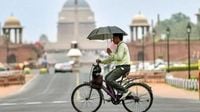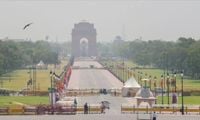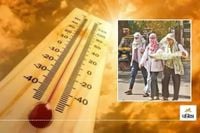As summer takes hold across India, the weather has turned increasingly severe, with heatwaves gripping many states, particularly Delhi, Uttar Pradesh, Bihar, and Rajasthan. On April 21, 2025, Delhi recorded its hottest April day in six years, with temperatures soaring to 41.3 degrees Celsius, which is 3.6 degrees above the seasonal average. The India Meteorological Department (IMD) reported that the maximum temperature in the Ridge area reached 41.9 degrees Celsius, while the minimum was recorded at 26.2 degrees Celsius, significantly higher than the average for this time of year.
People in the capital are feeling the impact of the soaring temperatures, with many opting to stay indoors, especially after 11 AM. The discomfort is compounded by humidity levels fluctuating between 15% and 59%, which has made the heat feel even more oppressive. The IMD forecasts that on April 22, the maximum temperature will remain around 40 degrees Celsius, with the minimum expected to be around 24 degrees Celsius. This trend of high temperatures is expected to continue until April 27, 2025.
Meanwhile, in Madhya Pradesh, authorities have issued heatwave alerts for five districts, including Ratlam, Guna, Sagar, Damoh, and Sidhi, where temperatures are predicted to reach as high as 42 degrees Celsius. The preceding day saw temperatures above 40 degrees Celsius in 26 cities across the state.
In contrast, the weather in Jammu and Kashmir has taken a tragic turn, with three fatalities reported due to a cloudburst in the Ramban district on April 20. The incident led to landslides that blocked the Jammu-Srinagar Highway, causing significant disruption. Authorities have advised travelers to avoid the highway until conditions improve.
As the heatwave continues to affect various regions, Uttar Pradesh has issued a red alert for thunderstorms and rain across 38 districts, including Varanasi, with wind speeds expected to reach 50-60 km/h. This weather change is attributed to an Iranian disturbance impacting the region.
In Bihar, light rain is anticipated in four districts, but temperatures are expected to rise again after April 23. The weather department has issued warnings for the potential of heatwaves in the state as well.
In Haryana, the weather is expected to remain clear, but rain alerts have been issued for five districts, including Panchkula and Yamunanagar. The maximum temperatures in these areas have also been quite high, with some regions experiencing temperatures above 40 degrees Celsius.
Across the country, the IMD has issued yellow alerts for many states, indicating that heatwave conditions are likely to persist. The maximum temperatures are expected to rise by 2-3 degrees Celsius in northwest India, while eastern regions may see increases of 4-6 degrees Celsius over the next few days.
In Odisha, the situation is dire, with Jharsuguda reporting a maximum temperature of 45.3 degrees Celsius. Residents are struggling with the extreme heat, prompting officials to issue advisories for outdoor workers.
As weather patterns shift across India, the IMD has warned of possible hailstorms and thunderstorms in several states. The western Himalayan region is likely to experience light to moderate rainfall, along with high winds. The weather department has also forecast heavy rain in northeastern states, including Assam and Meghalaya.
The ongoing heatwave has prompted school authorities in Jaipur to adjust school timings for younger students to avoid the peak heat hours. The district collector has ordered that classes for grades 1-8 start at 7:30 AM and end by 11:30 AM, while higher classes will continue as scheduled.
As we look ahead, the IMD predicts a continued rise in temperatures across various states, with heatwave conditions expected to last until at least the end of April. Residents are urged to stay hydrated and avoid unnecessary exposure to the sun during the hottest parts of the day.
In summary, the weather across India presents a mixed bag of challenges, from extreme heat in the north and central regions to thunderstorms and rain in the east and south. As the country navigates these conditions, the focus remains on keeping communities safe and informed.










